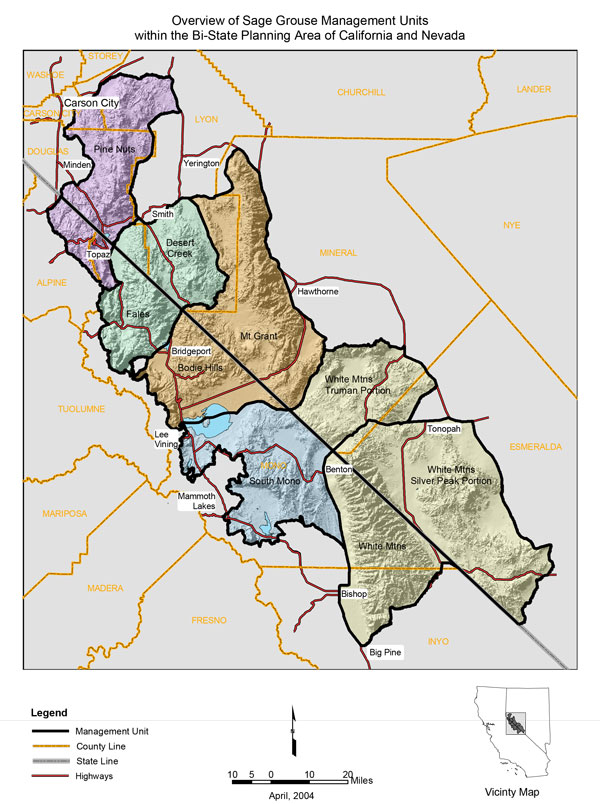ELC Win Compels Federal Government to Reconsider Endangered Species Act Protections for the Bi-State Sage Grouse
After a several-year battle, Environmental Law Clinic students have shown that bi-state sage grouse – large, striking birds known for their distinctive mating dance – warrant reconsideration for federal protection as a threatened species.
In response to a lawsuit filed by ELC and the Center for Biological Diversity on behalf of the Center, Western Watersheds Project, and WildEarth Guardians, the U.S. District Court for the Northern District of California issued a ruling this May concluding that the U.S. Fish and Wildlife Service erred in withdrawing a 2013 decision to list bi-state sage grouse as a threatened species under the Endangered Species Act. The court held that the Service failed to rely on the best available science, as the Act requires, in concluding that that the sage grouse’s population is above the minimum threshold for viability, and that the likely disappearance of vulnerable subpopulations would be inconsequential for the species’ long-term viability. The court held that these errors “go to the heart of the Service’s listing decision and are not harmless,” and directed the Service to go back to the drawing board and reach a new decision.
Clinic student Daniel Ahrens (JD ’23), who co-wrote the summary judgment briefing and presented oral argument in federal court, said that “the decision reinforces important legal principles for endangered species: that agencies must base their decisions on the best available science, fully explain their decisions, and carefully consider the status of an imperiled species, especially segments that are small and vulnerable. The evidence before the Fish & Wildlife Service showed that the bi-state sage grouse is in danger and that the Service must do more to consider and protect it.” Clinic student Zach Rego (JD ’23), who also co-wrote the briefing and presented oral argument alongside Ahrens, added that the court was right to hold that the Service “also must do more to show that conservation measures, like the removal of invasive cheatgrass, will be effective in preventing the bi-state sage grouse’s extinction.”
In addition to Ahrens and Rego, ELC students Chris Meyer (JD ’22) and Mikaela Pyatt (JD ‘22) co-wrote the summary judgment briefs in this matter, along with valuable input from Center for Biological Diversity senior attorney Lisa Belenky.
Background on the battle to protect the bi-state sage grouse

Under pressure from mining, grazing, and other development, the bi-state sage grouse has lost half of its historic population and habitat. The already-fragmented sagebrush habitat in which the grouse lives is further threatened by wildfires, climate change, and invasive plants that eliminate critical cover for the birds’ chicks. Today, the bi-state sage grouse is reduced to only six small, isolated subpopulations along the California-Nevada border.
Because of these dire conditions, the Service concluded in 2013 that the species should be listed as threatened under the Endangered Species Act. But two years later, in an abrupt about-face, the government withdrew the proposal to list the bi-state sage grouse and concluded that listing was not warranted. ELC and the Center for Biological Diversity, on behalf of a coalition of conservation groups, sued the federal government challenging the Service’s withdrawal decision.
In 2018, the U.S. District Court for the Northern District of California sided with the plaintiffs in holding that that the U.S. Fish and Wildlife’s definition of what constitutes a “significant” part of a species’ range was an “impermissible interpretation” of the Endangered Species Act’s statutory language. The decision compelled the Fish and Wildlife Service to revisit the proposed listing, but in 2020 it once again decided not to list the species. ELC and the Center for Biological Diversity sued again in 2020 and won on summary judgment on May 16, 2022.
The Fish and Wildlife Service must now issue a new final listing decision. In its summary-judgment order, the court reinstated the Service’s 2013 proposal to list the species as threatened while the Service prepares a new decision. We remain hopeful that the Service will decide to list the bi-state sage grouse as threatened, thereby giving this critically imperiled species a real chance at survival.
